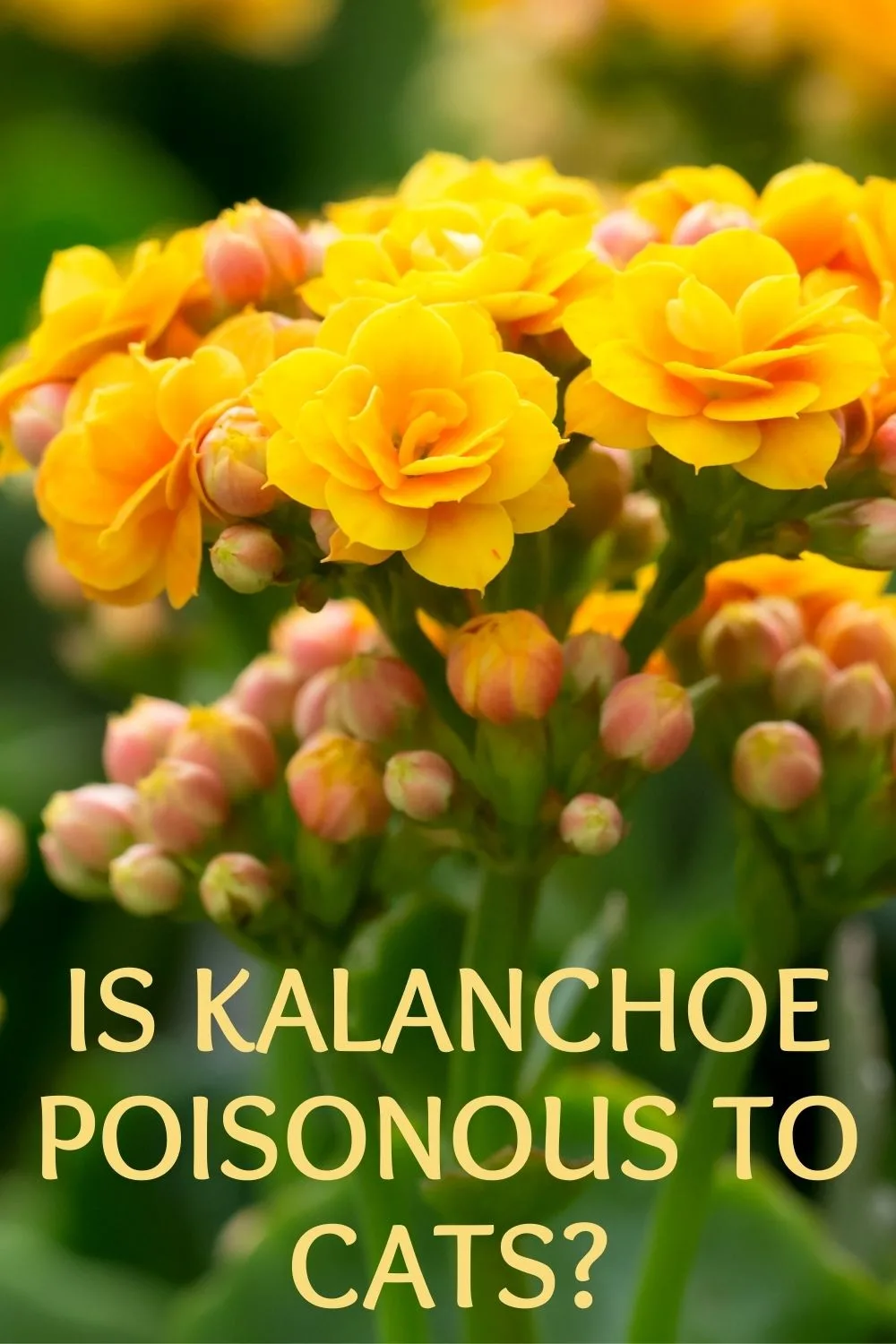If you love to keep houseplants and you also have cats, you may find yourself wondering, “is kalanchoe poisonous to cats?” Responsible pet parents will take time to educate themselves on which houseplants are safe and which are toxic to their beloved animals.
It’s important to know that, yes, kalanchoe can be poisonous to cats. This common houseplant contains toxins that can make your cat ill when ingested. It does not cause any harm unless it is eaten, meaning it doesn’t release any dangerous spores into the air.

It’s very important to protect your cats from toxic plants in the home. Even if your cat has never eaten a plant before, there’s always a chance he could. Our pets depend on us as pet parents to keep them safe. This means positively identifying our houseplants that they may come into contact with and making sure you don’t bring any plants in that can cause your cat harm.
What is Kalanchoe?

Kalanchoe is a genus of flowering plants in the family Crassulaceae, native to Madagascar and tropical Africa. Kalanchoes are characterized by their succulent leaves and colorful flowers. While Kalanchoe is not technically poisonous to cats, it can cause gastrointestinal upset if ingested in large quantities.
This beautiful houseplant is also popular in outdoor gardens. If your cat doesn’t go outside, this may be a better option for you to keep it at home, but also keep your cat safe. Kalanchoe is usually propagated by stem cuttings and comes in a variety of colors including pink, red, yellow, and white. Here’s how to grow kalanchoe.
Kalanchoe is also known as the “Mother-in-Law’s Tongue” or “Devil’s Backbone”, due to its sharp leaves. If you have a cat that likes to nibble on plants, it is best to keep kalanchoe out of reach. Even cats who have never eaten plants before can sometimes decide to do so at random. The short of it: this plant can make your cat sick.
If your cat loves to chew on greens, get her some cat grass, and she’ll leave your other plants alone. The one below is one of my favorites.
What is Kalanchoe Poisoning?
The Kalanchoe plant contains toxins that can cause gastrointestinal upset in cats if ingested. Clinical signs of Kalanchoe toxicity in cats include drooling, vomiting, and diarrhea. In severe cases, Kalanchoe toxicity can lead to liver failure. If you suspect that your cat has ingested Kalanchoe, please contact your veterinarian immediately.
If you are a cat owner and a plant lover, it can benefit you to keep a list of plants that are dangerous to kitties someplace that you can see regularly so you can avoid bringing these toxic plants into your home where your kitties live.
Symptoms of kalanchoe poisoning
It’s important to know the signs of possible poisoning in your cat so that you can seek treatment. You can also call the pet poison helpline any time day or night if you have questions.
Some symptoms of kalanchoe poisoning in cats include:
- Abdominal pain
- Gastrointestinal irritation
- Drooling
- Vomiting
- Diarrhea
- Lethargy
- Abnormal heart rhythm
In extreme cases, your cat may also experience:
- Liver failure
- Kidney failure
- Heart arrhythmia
- Tremors
Your vet will know how to identify the clinical signs of poisoning from toxic plants. It’s important to remember that cats are excellent at hiding signs of illness so your pet may not show any symptoms at all unless it’s really severe.
What to do if your cat ingests kalanchoe
If your cat has eaten Kalanchoe, it is important to seek veterinary care immediately. In severe cases, Kalanchoe toxicity can lead to tremors, seizures, and heart arrhythmias. If you suspect that your cat has ingested Kalanchoe, contact your veterinarian or the ASPCA Animal Poison Control Center at (888) 426-4435.
Don’t try to treat the problem yourself at home or “wait it out”. When it comes to poisonings, you don’t want to take any chances. Also, cats are in danger of getting dehydrated very quickly and if you try to wait for it to pass, they can become dangerously dehydrated.
When you first discover your cat has eaten this plant, try to keep them calm and quiet to prevent further stomach upset. Second, make sure they don’t have any pieces of the plant still in their mouth. You might also try to give them a few small sips of water to help ease their stomach.
Treatment for kalanchoe poisoning
Treatment will vary depending on the severity of the toxicity but may include IV fluids, medications to control vomiting, and close monitoring. The extent of the treatment can depend on how much was ingested and your cat, since every cat can react differently.
Is Kalanchoe Poisonous to Cats? Conclusion
As you can see, kalanchoe can make your cats sick. It may not be labeled as dangerous as some other plants, but it’s not recommended that you keep it in the home if you also have cats. The only way to 100% avoid this is to not bring it into your home at all.
You should keep all potentially toxic plants out of your home unless you have them caged in or in some other place where you know your cats cannot access them. All it takes is one time when you’re not looking or not home for a fatal accident to occur.

Lisa Clark is a freelance writer who grew up on farmland, then moved to the city, and has now retired back to her rural roots. She's having fun teaching her kids about gardening, planting flowers, and collecting houseplants.



How To Grow Kalanchoe Blossfeldiana
Wednesday 7th of December 2022
[…] If you have cats, keep these plats in a place where cats can’t get to it, becasue kalanchoe is poisonous to cats. […]